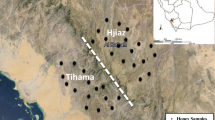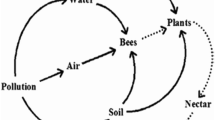Abstract
In this study, honeysuckle, a common Chinese herbal medicine, produced from different areas was investigated for total arsenic and arsenic species concentration. The total arsenic concentrations were determined by inductively coupled plasma mass spectrometry (ICP-MS) and ranged from 275 to 635 μg kg−1. A microwave-assisted procedure with 1 % phosphoric acid (v/v) was used for the extraction of arsenic species in honeysuckle. The total arsenic species concentration found by liquid chromatography-inductively coupled plasma mass spectrometry (LC-ICP-MS) was in agreement with the total arsenic concentration determined by the ICP-MS analysis after the microwave digestion. Arsenate (As(V)) with an average proportion of 54.3 % was the predominant arsenic species in honeysuckle. The order of concentration is as follows: As(V) > arsenite (As(III)) > dimethylarsinic acid (DMA) > arsenobetaine (AsB) > monomethylarsonic acid (MMA). The proportion of organic arsenic (24.7 %) was higher than that in most terrestrial plants. Moreover, the distributions of arsenic species in the honeysuckle from different producing areas were significantly different. This study provides useful information for better understanding of the distribution of arsenic species in terrestrial plants.



Similar content being viewed by others
References
Chen X, Lin HZ, Jiang SG, Wu KC, Liu YJ, Tian LX, Zhang YQ, Niu J (2013) Dietary supplementation of honeysuckle improves the growth, survival and immunity of Penaeus monodon. Fish Shellfish Immunol 35(1):161–169
Jiang C, Yuan Y, Chen M, Huang L (2013) Molecular authentication of multi-species honeysuckle tablets. Genet Mol Res 12(4):4827–4835
Ikeda N, Ishihara M, Tsuneya T, Kawakita M, Yoshihara M, Suzuki Y, Komaki R, Inui M (1994) Volatile components of honeysuckle (Lonicera japonica Thunb.) flowers. Flavour Fragr J 9(6):325–331
Zhang B, Yang R, Zhao Y, Liu C-Z (2008) Separation of chlorogenic acid from honeysuckle crude extracts by macroporous resins. J Chromatogr B 867(2):253–258
Xiang Z, Ning Z (2008) Scavenging and antioxidant properties of compound derived from chlorogenic acid in South-China honeysuckle. LWT-Food Sci Technol 41(7):1189–1203
Ernst E (2002) Toxic heavy metals and undeclared drugs in Asian herbal medicines. Trends Pharmacol Sci 23(3):136–139
Lin CG, Schaider LA, Brabander DJ, Woolf AD (2010) Pediatric lead exposure from imported Indian spices and cultural powders. Pediatrics 125(4):e828–e835
Liang W, Lin S, Yen K, Yang L (1998) Metal element analysis of commercial Chinese herbal medicines. Taiwan Kexue 51(2):37–56
Garvey GJ, Hahn G, Lee RV, Harbison RD (2001) Heavy metal hazards of Asian traditional remedies. Int J Environ Health Res 11(1):63–71
Shmalberg J, Hill R, Scott K (2013) Nutrient and metal analyses of Chinese herbal products marketed for veterinary use. J Anim Physiol Anim Nutr 97(2):305–314
The Ministry of Commerce of the People’s Republic of China (2004) WM/T 2-2004. Green standards of medicinal plants and preparations for foreign trade and economy
Wah HLK, Ramchurn K, Alladin SB (2014) Metal levels in traditional Chinese and Ayurvedic medicines. In: Chemistry: the key to our sustainable future. Springer, pp 321-337
Wang S, Wu X, Tan M, Gong J, Tan W, Bian B, Chen M, Wang Y (2012) Fighting fire with fire: poisonous Chinese herbal medicine for cancer therapy. J Ethnopharmacol 140(1):33–45
McKinney JD (1992) Metabolism and disposition of inorganic arsenic in laboratory animals and humans. Environ Geochem Health 14(2):43–48
Peraza M, Carter D, Gandolfi A (2003) Toxicity and metabolism of subcytotoxic inorganic arsenic in human renal proximal tubule epithelial cells (HK-2). Cell Biol Toxicol 19(4):253–264
Lou C, Liu W, Liu X (2014) Quantitative analysis of arsenic speciation in guano and ornithogenic sediments using microwave-assisted extraction followed by high-performance liquid chromatography coupled to hydride generation atomic fluorescence spectrometry. J Chromatogr B 969:29–34
Liu XJ, Zhao QL, Sun GX, Williams P, Lu XJ, Cai JZ, Liu WJ (2013) Arsenic speciation in Chinese herbal medicines and human health implication for inorganic arsenic. Environ Pollut 172:149–154. doi:10.1016/j.envpol.2012.09.009
Lehmann E, Fostier A, Arruda M (2013) Hydride generation using a metallic atomizer after microwave-assisted extraction for inorganic arsenic speciation in biological samples. Talanta 104:187–192
Tsai C-Y, Jiang S-J (2011) Microwave-assisted extraction and ion chromatography dynamic reaction cell inductively coupled plasma mass spectrometry for the speciation analysis of arsenic and selenium in cereals. Anal Sci 27(3):271
Jedynak L, Kowalska J, Harasimowicz J, Golimowski J (2009) Speciation analysis of arsenic in terrestrial plants from arsenic contaminated area. Sci Total Environ 407(2):945–952
Razic S, Kuntic V (2013) Diverse elements in herbal tea products consumed in Serbia using inductively coupled plasma mass spectrometry. Int J Food Prop 16(1):1–8
Nookabkaew S, Rangkadilok N, Satayavivad J (2006) Determination of trace elements in herbal tea products and their infusions consumed in Thailand. J Agric Food Chem 54(18):6939–6944
Naithani V, Kakkar P (2005) Evaluation of heavy metals in Indian herbal teas. Bull Environ Contam Toxicol 75(1):197–203
Abedin MJ, Cresser MS, Meharg AA, Feldmann J, Cotter-Howells J (2002) Arsenic accumulation and metabolism in rice (Oryza sativa L.). Environ Sci Technol 36(5):962–968
Mihucz VG, Tatár E, Virág I, Cseh E, Fodor F, Záray G (2005) Arsenic speciation in xylem sap of cucumber (Cucumis sativus L.). Anal Bioanal Chem 383(3):461–466
Zhao R, Zhao M, Wang H, Taneike Y, Zhang X (2006) Arsenic speciation in moso bamboo shoot—a terrestrial plant that contains organoarsenic species. Sci Total Environ 371(1):293–303
Acknowledgments
This work was supported by the Special Fund for Forestry Scientific Research in the Public Interest (201304705), the Special Funds from the Central Scientific Research Institute of Public Welfare (RISF2013011), and Open Fund of Zhejiang Provincial Key Laboratory of Chemical Utilization of Forestry Biomass (2014lCUFB03).
Author information
Authors and Affiliations
Corresponding author
Rights and permissions
About this article
Cite this article
Tang, F., Ni, Z., Liu, Y. et al. Arsenic Speciation in Honeysuckle (Lonicera japonica Thunb.) from China. Biol Trace Elem Res 168, 269–275 (2015). https://doi.org/10.1007/s12011-015-0327-2
Received:
Accepted:
Published:
Issue Date:
DOI: https://doi.org/10.1007/s12011-015-0327-2




